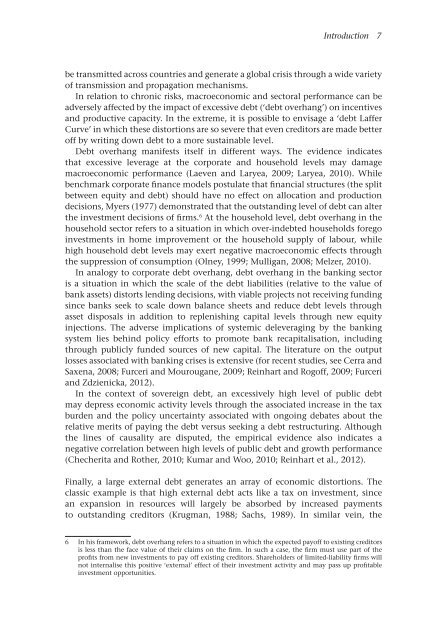1qGLG9p
1qGLG9p
1qGLG9p
Create successful ePaper yourself
Turn your PDF publications into a flip-book with our unique Google optimized e-Paper software.
Introduction 7<br />
be transmitted across countries and generate a global crisis through a wide variety<br />
of transmission and propagation mechanisms.<br />
In relation to chronic risks, macroeconomic and sectoral performance can be<br />
adversely affected by the impact of excessive debt (‘debt overhang’) on incentives<br />
and productive capacity. In the extreme, it is possible to envisage a ‘debt Laffer<br />
Curve’ in which these distortions are so severe that even creditors are made better<br />
off by writing down debt to a more sustainable level.<br />
Debt overhang manifests itself in different ways. The evidence indicates<br />
that excessive leverage at the corporate and household levels may damage<br />
macroeconomic performance (Laeven and Laryea, 2009; Laryea, 2010). While<br />
benchmark corporate finance models postulate that financial structures (the split<br />
between equity and debt) should have no effect on allocation and production<br />
decisions, Myers (1977) demonstrated that the outstanding level of debt can alter<br />
the investment decisions of firms. 6 At the household level, debt overhang in the<br />
household sector refers to a situation in which over-indebted households forego<br />
investments in home improvement or the household supply of labour, while<br />
high household debt levels may exert negative macroeconomic effects through<br />
the suppression of consumption (Olney, 1999; Mulligan, 2008; Melzer, 2010).<br />
In analogy to corporate debt overhang, debt overhang in the banking sector<br />
is a situation in which the scale of the debt liabilities (relative to the value of<br />
bank assets) distorts lending decisions, with viable projects not receiving funding<br />
since banks seek to scale down balance sheets and reduce debt levels through<br />
asset disposals in addition to replenishing capital levels through new equity<br />
injections. The adverse implications of systemic deleveraging by the banking<br />
system lies behind policy efforts to promote bank recapitalisation, including<br />
through publicly funded sources of new capital. The literature on the output<br />
losses associated with banking crises is extensive (for recent studies, see Cerra and<br />
Saxena, 2008; Furceri and Mourougane, 2009; Reinhart and Rogoff, 2009; Furceri<br />
and Zdzienicka, 2012).<br />
In the context of sovereign debt, an excessively high level of public debt<br />
may depress economic activity levels through the associated increase in the tax<br />
burden and the policy uncertainty associated with ongoing debates about the<br />
relative merits of paying the debt versus seeking a debt restructuring. Although<br />
the lines of causality are disputed, the empirical evidence also indicates a<br />
negative correlation between high levels of public debt and growth performance<br />
(Checherita and Rother, 2010; Kumar and Woo, 2010; Reinhart et al., 2012).<br />
Finally, a large external debt generates an array of economic distortions. The<br />
classic example is that high external debt acts like a tax on investment, since<br />
an expansion in resources will largely be absorbed by increased payments<br />
to outstanding creditors (Krugman, 1988; Sachs, 1989). In similar vein, the<br />
6 In his framework, debt overhang refers to a situation in which the expected payoff to existing creditors<br />
is less than the face value of their claims on the firm. In such a case, the firm must use part of the<br />
profits from new investments to pay off existing creditors. Shareholders of limited-liability firms will<br />
not internalise this positive ‘external’ effect of their investment activity and may pass up profitable<br />
investment opportunities.


